In geometry, a quadrilateral is a polygon with four sides, four vertices, and four angles. The sum of the interior angles of any quadrilaterals is always 360 degrees. A quadrilateral has two diagonals, which are line segments joining opposite vertices. The term “quadrilateral” is derived from two Latin roots; “quadri” meaning “four”, and “latus”, meaning “side.” So, the word literally means “four sides.” Quadrilateral is also called tetragon, derived from Greek word “tetra” meaning “four” and “gon” meaning “angle”. It is similarly called “quadrangle.”
Table of Contents
Definition–
A quadrilateral is a two-dimensional plane figure enclosed by 4 line segments, and also has four vertices and four angles.
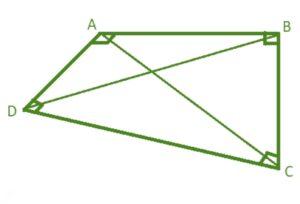
Real-life examples of Quadrilaterals:
There are many real-life quadrilateral examples: The floor, walls, ceiling, chessboard.
Types of Quadrilaterals and their Properties:
Some special types of quadrilaterals and their Properties are :
Square: A square is a regular quadrilateral, with four equal sides and four equal angles.
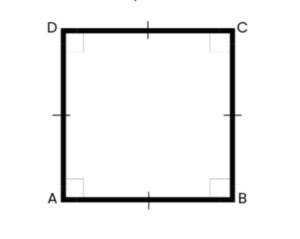
Properties of square:
- All four sides are equal.
- Opposite sides parallel.
- Each of the angles measuring 90°.
- The two diagonals of the square are equal to each other.
Rectangle: A rectangle is a quadrilateral in which the opposite sides are parallel and equal to each other.
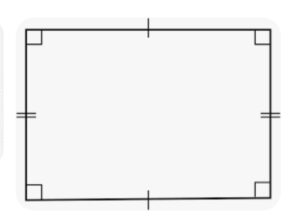
Properties of Rectangle:
- Opposite sides equal.
- Opposite sides parallel.
- Each of the angles measuring 90°.
- The diagonals of a rectangle are the same length.
Parallelogram: A parallelogram is a quadrilateral, whose opposite sides are parallel to each other.
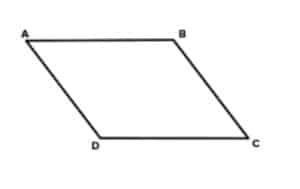
Properties of Parallelogram:
- Opposite side equal.
- Opposite sides parallel.
- Opposite angles equal.
- The diagonals of a parallelogram are not equal in length.
Rhombus: A rhombus is a quadrilateral that has all its four sides equal in length.

Properties of Rhombus:
- All its sides equal.
- Opposite sides parallel.
- Opposite angles equal.
- The diagonals of a rhombus are not equal in length.
Trapezium: A trapezium is a quadrilateral with one pair of opposite sides are parallel.
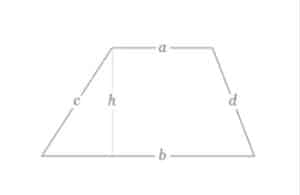
Properties of Trapezium:
- One pair of opposite sides parallel.
- Sum of all the four angles of the trapezium is equal to 360°.
Isosceles Trapezium : A isosceles trapezium is a quadrilateral whose one pair of opposite sides are parallel.

Properties of Isosceles Trapezium:
- One pair of opposite sides parallel.
- The other pair of opposite sides equal.
- Angles opposite to equal sides equal.
Kite: A kite is a quadrilateral that has 2 pairs of adjacent sides are equal.
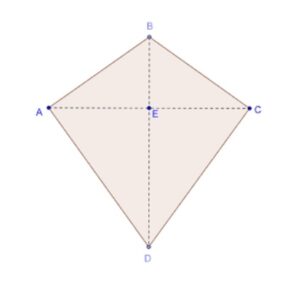
Properties of Kite:
- The two diagonals of a kite bisect each other at 90 degrees.
- The angles opposite to the main diagonal are equal.
Apart from these 6 types, Quadrilateral can also be classified as:
- Concave Quadrilaterals.
- Convex Quadrilaterals.
- Intersecting Quadrilaterals, and last but not least “Cyclic Quadrilateral.”
Perimeter of Quadrilateral Formulas:
- Perimeter of Rectangle =2(Length+ Breadth)
- Perimeter of Square= 4×Side
- Perimeter of Parallelogram = 2× sum of two adjacent sides.
- Perimeter of Rhombus= 4×side.
- Perimeter of Trapezium = Sum of all four sides.
- Perimeter of Kite = Sum of all four sides.
Area of Quadrilateral Formulas:
- Area of Rectangle = Length × Breadth
- Area of Square = Side × Side
- Area of Parallelogram = Base × Height
- Area of Rhombus = (Diagonal1 × Diagonal2) ÷2
- Area of Kite = (Diagonal1× Diagonal2 ) ÷2
- Area of Trapezium = ½×(Sum of its parallel sides)× Height
Diagonal of Quadrilaterals:
- Diagonal of Square = Side length × √2
- Diagonal of Rectangle = √(L2+B2), where L is the length and B is the Breadth of the Rectangle.
FAQs:
- What is the sum of the interior angles of a Quadrilaterals?
Answer – The sum of all the interior angles of a Quadrilateral is 360°.
2. What type of quadrilateral has all angles measuring 90°, and opposite sides measuring equal?
Answer – Rectangle.
3.How many sides are there in a quadrilateral?
Answer – 4 sides.
4. What is the sum of the exterior angles of a quadrilateral?
Answer – The sum of all the exterior angles of a quadrilateral is 360°.

